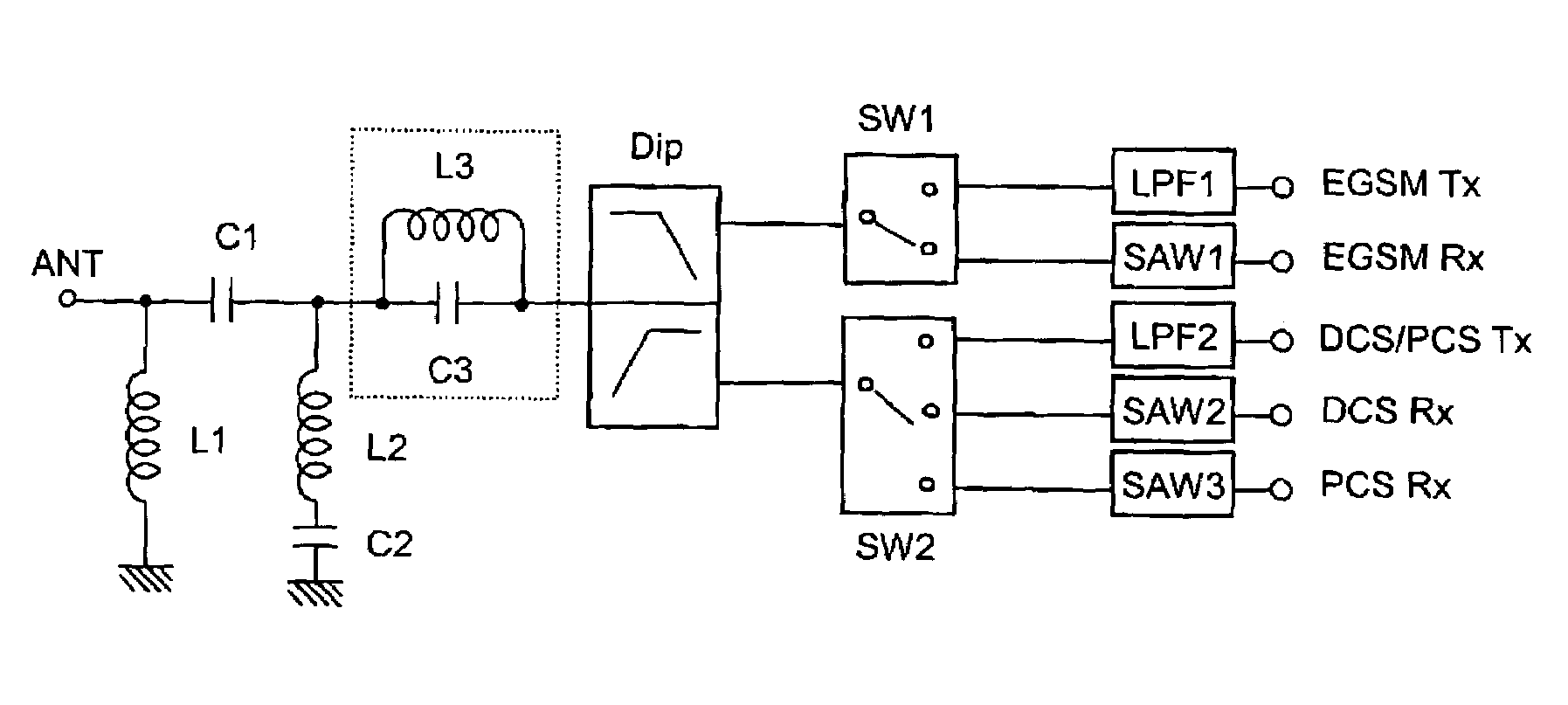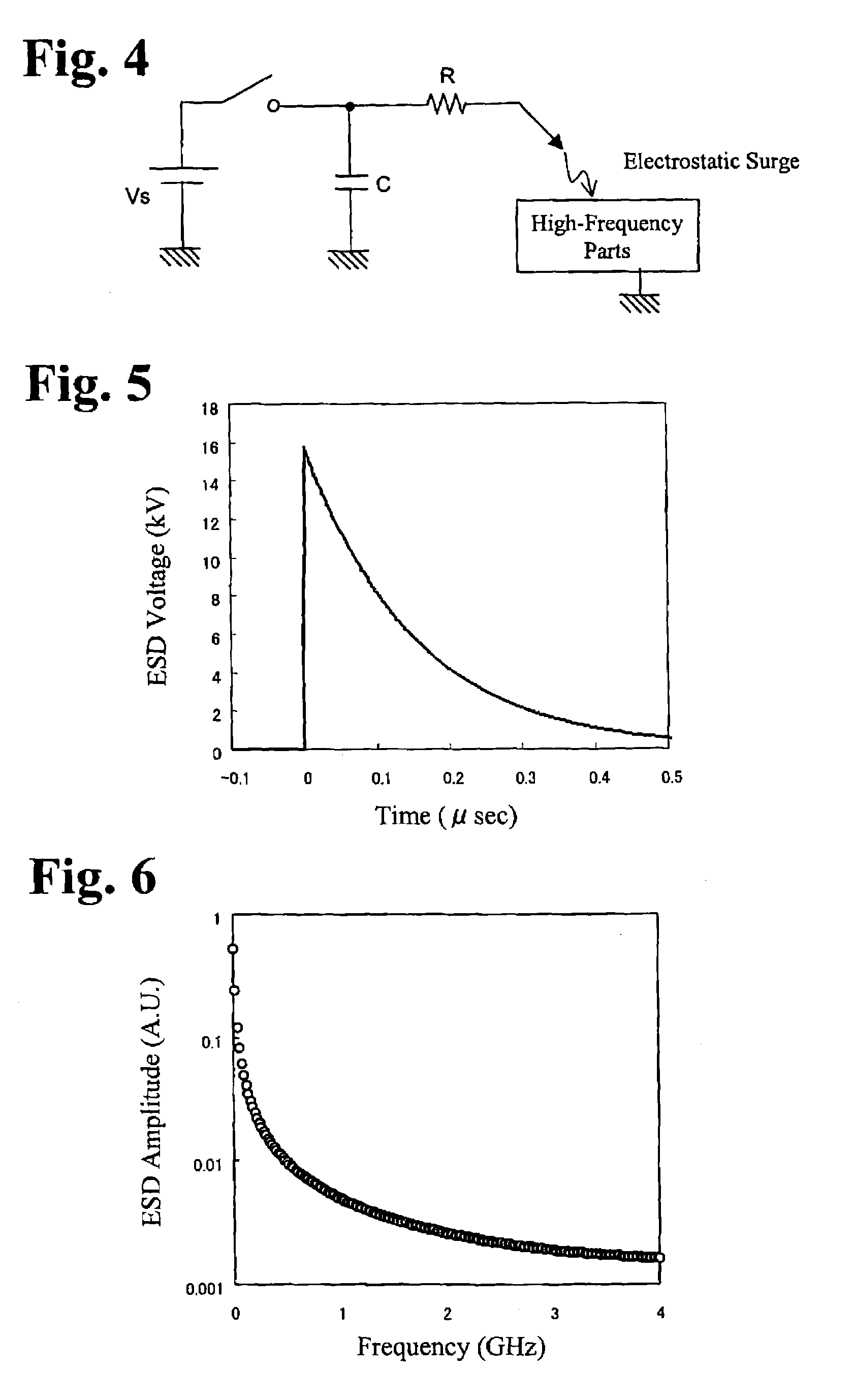Bypass filter, multi-band antenna switch circuit, and layered module composite part and communication device using them
a multi-band antenna switch circuit and composite part technology, applied in the field of wireless communication systems, can solve the problems of unsuitably large volume and weight of mobile communications devices, unsuitable high-frequency parts, and sometimes disconnected mobile phones
- Summary
- Abstract
- Description
- Claims
- Application Information
AI Technical Summary
Benefits of technology
Problems solved by technology
Method used
Image
Examples
example 1
[0088]FIG. 3 is a block diagram showing one example of a tripleband antenna switch circuit comprising the electrostatic-surge-removing highpass filter of the present invention. In this Example, the diplexer Dip causes branching to an EGSM-band signal (880 to 960 MHz) and a DCS / PCS-band signal (DCS: 1710 to 1880 MHz, PCS: 1850 to 1990 MHz). The switch circuit SW1 switches the transmitting and receiving of EGSM, and the switch circuit SW2 switches DCS / PCS transmission, DCS receiving and PCS receiving. The lowpass filter LPF1 attenuates an n-th harmonic strain contained in a transmission signal sent from the EGSM TX terminal, and the lowpass filter LPF2 attenuates an n-th harmonic strain contained in a transmission signal sent from the DCS / PCS TX terminal. The SAW filters SAW1, SAW2, SAW3 remove noises outside the receiving band from each receiving signal of EGSM, DCS and PCS.
[0089]The electrostatic-surge-removing circuit disposed between the antenna terminal ANT and the diplexer Dip c...
example 2
[0095]FIG. 9 is a block diagram showing a tripleband antenna switch circuit adapted for EGSM, DCS and W-CDMA according to one embodiment of the present invention. Branched by the diplexer Dip are signals from the antenna in a band of 880 to 960 MHz for EGSM (transmission frequency: 880 to 915 MHz, receiving frequency: 925 to 960 MHz), and in a band of 1710 to 2170 MHz for DCS (transmission frequency: 1710 to 1785 MHz, receiving frequency: 1805 to 1880 MHz) and W-CDMA (transmission frequency: 1920 to 1980 MHz, receiving frequency: 2110 to 2170 MHz).
[0096]The switch circuit SW1 switches EGSM signals branched by the diplexer Dip to the transmission terminal EGSM Tx and the receiving terminal EGSM Rx. The switch circuit SW2 switches DCS or W-CDMA signals branched by the diplexer Dip to the transmission terminal DCS Tx, the receiving terminal DCS Rx and the transmitting / receiving terminal W-CDMA. To suppress n-th harmonic strain included in transmission signals sent from the power amplif...
example 3
[0115]FIG. 11 is a block diagram showing an antenna switch circuit adapted for EGSM, DCS and W-CDMA. The circuit of this Example is the circuit shown in FIG. 9, in which a first notch filter NF1 is disposed between the diplexer Dip and the first switch circuit SW1. The notch filter NF1 may comprise a parallel resonance circuit and / or a serial resonance circuit shown in FIGS. 14(a) and 14(b), respectively. In this case, the resonance frequency is preferably set to be two or three times the transmission frequency of EGSM. Because the notch filter NF1 removes harmonic strain generated at the first high-frequency switch SW1 in this Example, harmonics generated by the antenna is further suppressed.
PUM
 Login to View More
Login to View More Abstract
Description
Claims
Application Information
 Login to View More
Login to View More - R&D
- Intellectual Property
- Life Sciences
- Materials
- Tech Scout
- Unparalleled Data Quality
- Higher Quality Content
- 60% Fewer Hallucinations
Browse by: Latest US Patents, China's latest patents, Technical Efficacy Thesaurus, Application Domain, Technology Topic, Popular Technical Reports.
© 2025 PatSnap. All rights reserved.Legal|Privacy policy|Modern Slavery Act Transparency Statement|Sitemap|About US| Contact US: help@patsnap.com



